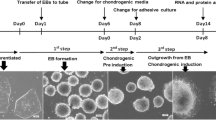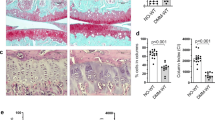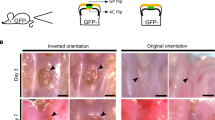Abstract
Osteoarthritis is a huge health burden to our society. Seeking for potential ways to induce regeneration of articular cartilage (AC) that is intrinsically limited, we focused on the interaction between two opposing joints. To evaluate the role of the interaction of opposing regions of AC for joint maturation, we amputated digits at the distal interphalangeal level without injuring the articular surface of the intermediate phalanx (P2) and observed that the zonal organization of AC was defective. We then removed the P2 bone without injuring the articular surface of the proximal phalanx (P1), and the remaining part of the digit was amputated near the distal interphalangeal level. The distribution pattern of type II collagen and proteoglycan 4 (PRG4) suggested that maturation of AC in P1 was delayed. These two experiments suggested that an interaction between the opposing AC in a joint is necessary for maturation of the zonal organization of AC in neonatal digits. To test if an interaction of the joints is sufficient to induce articular cartilage, a proximal fragment of P2 was resected, inverted, and put back into the original location. Newly formed cartilage was induced at the interface region between the AC of the inverted graft and the cut edge of the distal part of P2. Type II collagen and PRG4 were expressed in the ectopic cartilage in a similar manner to normal AC, indicating that neonatal AC can induce ectopic joint-like structures in mice comparable with what has been reported in newts and frogs. These results suggest that the neonatal joint could be a source of inductive signals for regeneration of AC.
Lay Summary
In this study, we experimentally show that neonatal mice appear to have the capacity to regenerate articular cartilage (AC) in digits. It is already known that mice can regenerate a digit tip after amputation, but do not regenerate in response to amputations at more proximal levels. Therefore, it has been thought that mammalian joint structures are non-regenerative. However, we found that normal digit AC can induce AC-like structures in a non-joint region when it is placed next to the cut edge of a bone, suggesting that the normal AC has regenerative capacity in certain situations in neonatal mice.
Future Works
Joint disorders are a huge health problem of our society. The results of this study suggest that neonatal AC could be a potential source of inductive signals for regeneration of AC. The discovery of these inductive signals will aid in develo** regenerative therapies of a joint in human.
Similar content being viewed by others
Avoid common mistakes on your manuscript.
Introduction
Synovial joints are a fundamental organ in skeletal function, which consists of opposing articular cartilage, tendons, ligaments, and synovium. Discovering how to regenerate joint structures is strongly desired because of its functional importance and the reality that articular cartilage (AC) deteriorates over time causing osteoarthritis. Currently, it is unclear why AC fails to be regenerated [1,32]; therefore, whether the interzone is regenerated or not is still unclear. We need to examine expression and function of the molecules that play important roles in the interzone-mediated mechanism during formation of ectopic AC in the future studies.
It is also noteworthy that not only AC but also other tissues show signs of joint regeneration. In the proximal P2 inverted experiment, robust PRG4 expression is observed in the layer that lines the cavity between the P2 bone fragments and in the connective tissues, which is suggestive of synovial membrane regeneration. Tendon connection to the articular surface that is seen in hemiarticular amputation and resection is also an intriguing phenomenon for studying regeneration of the enthesis, which is an essential connective tissue for transmission of force between bone and tendon/ligament. Understanding regenerative responses of multiple tissues and how they can be coordinated will be required for the achievement of regeneration of the joint as an organ.
In conclusion, it appears that neonatal mouse digits innately demonstrate joint regenerative response in certain situations. BMP9 treatment might enhance and organize this hidden potency, resulting in successful joint regeneration [14]. Exploring AC-derived signaling is required for further understanding the mechanism of joint regeneration.
References
Ambrosi TH, Longaker MT, Chan CKF. A revised perspective of skeletal stem cell biology. Front Cell Dev Biol. 2019;7:189.
Li MH, **ao R, Li JB, Zhu Q. Regenerative approaches for cartilage repair in the treatment of osteoarthritis. Osteoarthr Cartil. 2017;25:1577–87.
van der Kraan PM. The interaction between joint inflammation and cartilage repair. Tissue Eng Regen Med. 2019;16:327–34.
Wallace H. Vertebrate limb regeneration. New York: John Wiley and Sons Ltd.; 1981.
Carlson BM. Principles of regenerative biology. New York: Academic Press; 2007.
Lee J, Gardiner DM. Regeneration of limb joints in the axolotl (Ambystoma mexicanum). PLoS One. 2012;7:e50615.
Tsutsumi R, Inoue T, Yamada S, Agata K. Reintegration of the regenerated and the remaining tissues during joint regeneration in the newt Cynops pyrrhogaster. Regeneration. 2015;2:26–36.
Endo T, Bryant SV, Gardiner DM. A stepwise model system for limb regeneration. Dev Biol. 2004;270:135–45.
Cosden RS, Lattermann C, Romine S, Gao J, Voss SR, MacLeod JN. Intrinsic repair of full-thickness articular cartilage defects in the axolotl salamander. Osteoarthr Cartil. 2011;19:200–5.
Namba RS, Meuli M, Sullivan KM, Le AX, Adzick NS. Spontaneous repair of superficial defects in articular cartilage in a fetal lamb model. J Bone Joint Surg Am. 1998;80:4–10.
Kumahashi N, Ochi M, Kataoka H, Uchio Y, Kakimaru H, Sugawara K, et al. Involvement of ATP, increase of intracellular calcium and the early expression of c-fos in the repair of rat fetal articular cartilage. Cell Tissue Res. 2004;317:117–28.
Ribitsch I, Mayer RL, Egerbacher M, Gabner S, Kanduła MM, Rosser J, et al. Fetal articular cartilage regeneration versus adult fibrocartilaginous repair: Secretome proteomics unravels molecular mechanisms in an ovine model. Dis Model Mech. 2018;11:dmm033092.
Shapiro F, Koide S, Glimcher MJ. Cell origin and differentiation in the repair of full-thickness defects of articular cartilage. J Bone Joint Surg Am. 1993;75:532–53.
Yu L, Dawson LA, Yan M, Zimmel K, Lin Y-L, Dolan CP, et al. BMP9 stimulates joint regeneration at digit amputation wounds in mice. Nat Commun. 2019;10:424.
Lee J, Marrero L, Yu L, Dawson LA, Muneoka K, Han M. SDF-1a/CXCR4 signaling mediates digit tip regeneration promoted by BMP-2. Dev Biol. 2013;382:98–109.
Ide H. Bone pattern formation in mouse limbs after amputation at the forearm level. Dev Dyn. 2012;241:435–41.
Ide H. Formation of distal bone elements in amputated neonatal mouse forelimbs. Integr J Orthop Traumatol. 2019;2:1–5.
Simkin J, Sammarco MC, Dawson LA, Schanes PP, Yu L, Muneoka K. The mammalian blastema: regeneration at our fingertips. Regeneration. 2015;2:93–105.
Han M, Yang X, Lee J, Allan CH, Muneoka K. Development and regeneration of the neonatal digit tip in mice. Dev Biol. 2008;315:125–35.
Fernando WA, Leininger E, Simkin J, Li N, Malcom CA, Sathyamoorthi S, et al. Wound healing and blastema formation in regenerating digit tips of adult mice. Dev Biol. 2011;350:301–10.
Takeo M, Chou WC, Sun Q, Lee W, Rabbani P, Loomis C, et al. Wnt activation in nail epithelium couples nail growth to digit regeneration. Nature. 2013;499:228–32.
Yu L, Han M, Yan M, Lee J, Muneoka K. BMP2 induces segment-specific skeletal regeneration from digit and limb amputations by establishing a new endochondral ossification center. Dev Biol. 2012;372:263–73.
Masaki H, Ide H. Regeneration potency of mouse limbs. Develop Growth Differ. 2007;49:89–98.
Chamberlain CS, Jeffery JJ, Leiferman EM, Yildirim T, Sun X, Baer GS, et al. Level-specific amputations and resulting regenerative outcomes in the mouse distal phalanx. Wound Repair Regen. 2017;25:443–53.
Miura S, Takahashi Y, Satoh A, Endo T. Skeletal callus formation is a nerve-independent regenerative response to limb amputation in mice and Xenopus. Regeneration. 2015;2:202–16.
Yu L, Han M, Yan M, Lee EC, Lee J, Muneoka K. BMP signaling induces digit regeneration in neonatal mice. Development. 2010;137:551–9.
Gardiner DM, Endo T, Bryant SV. The molecular basis of amphibian limb regeneration: integrating the old with the new. Semin Cell Dev Biol. 2002;13:345–52.
Suzuki M, Yakushiji N, Nakada Y, Satoh A, Ide H, Tamura K. Limb regeneration in Xenopus laevis froglet. Sci World J. 2006;6(Suppl 1):26–37.
Yokoyama H. Initiation of limb regeneration: the critical steps for regenerative capacity. Develop Growth Differ. 2008;50:13–22.
Goode RP. The regeneration of limbs in adult anurans. J Embryol Exp Morpholog. 1967;18:259–67.
Endo T, Tamura K, Ide H. Analysis of gene expressions during Xenopus forelimb regeneration. Dev Biol. 2000;220:296–306.
Tsutsumi R, Yamada S, Agata K. Functional joint regeneration is achieved using reintegration mechanism in Xenopus laevis. Regeneration. 2016;3:1–13.
Pacifici M, Koyama E, Iwamoto M. Mechanisms of synovial joint and articular cartilage formation: recent advances, but many lingering mysteries. Birth Defects Res C Embryo Today. 2005;75:237–48.
Hunziker EB, Kapfinger E, Geiss J. The structural architecture of adult mammalian articular cartilage evolves by a synchronized process of tissue resorption and neoformation during postnatal development. Osteoarthr Cartil. 2007;15:403–13.
Decker RS, Um HB, Dyment NA, Cottingham N, Usami Y, Enomoto-Iwamoto M, et al. Cell origin, volume and arrangement are drivers of articular cartilage formation, morphogenesis and response to injury in mouse limbs. Dev Biol. 2017;426:56–68.
Rux D, Decker RS, Koyama E, Pacifici M. Joints in the appendicular skeleton: developmental mechanisms and evolutionary influences. Curr Top Dev Biol. 2019;133:119–51.
Humason GL. Animal tissue techniques. San Francisco: Freeman; 1962.
Lehoczky JA, Robert B, Tabin CJ. Mouse digit tip regeneration is mediated by fate-restricted progenitor cells. Proc Natl Acad Sci. 2011;108:20609–14.
Rinkevich Y, Lindau P, Ueno H, Longaker MT, Weissman IL. Germ-layer and lineage-restricted stem/progenitors regenerate the mouse digit tip. Nature. 2011;476:409–13.
Dawson LA, Yu L, Yan M, Marrero L, Schanes PP, Dolan C, et al. The periosteal requirement and temporal dynamics of BMP2-induced middle phalanx regeneration in the adult mouse. Regeneration. 2017;4:140–50.
Dawson LA, Simkin J, Sauque M, Pela M, Palkowski T, Muneoka K. Analogous cellular contribution and healing mechanisms following digit amputation and phalangeal fracture in mice. Regeneration. 2016;3:39–51.
Egawa S, Miura S, Yokoyama H, Endo T, Tamura K. Growth and differentiation of a long bone in limb development, repair and regeneration. Develop Growth Differ. 2014;56:410–24.
Van der Kraan PM, Buma P, Van Kuppevelt T, Van Den Berg WB. Interaction of chondrocytes, extracellular matrix and growth factors: relevance for articular cartilage tissue engineering. Osteoarthr Cartil. 2002;10:631–7.
Lyons KM, Rosen V. BMPs, TGFβ, and border security at the interzone. Curr Top Dev Biol. 2019;133:153–70.
Rountree RB, Schoor M, Chen H, Marks ME, Harley V, Mishina Y, et al. BMP receptor signaling is required for postnatal maintenance of articular cartilage. PLoS Biol. 2004;2:e355.
Gao L, Sheu T, Dong Y, Hoak DM, Zuscik MJ, Schwarz EM, et al. TAK1 regulates SOX9 expression in chondrocytes and is essential for postnatal development of the growth plate and articular cartilages. J Cell Sci. 2013;126:5704–13.
Pitsillides AA. Early effects of embryonic movement: “A shot out of the dark.”. J Anat. 2006;208:417–31.
Archer CW, Dowthwaite GP, Francis-West P. Development of synovial joints. Birth Defects Res C Embryo Today. 2003;69:144–55.
Decker RS, Koyama E, Pacifici M. Genesis and morphogenesis of limb synovial joints and articular cartilage. Matrix Biol. 2014;39:5–10.
Acknowledgments
We thank David Gardiner and Susan Bryant for their critical reading of the manuscript. We also thank Ken Muneoka, Haruka Matsubara, Miyuki Suzuki, and Ken-ichi Suzuki for discussion.
Funding
This work was supported by JSPS KAKENHI Grant Numbers 18K06270 to TE and 16H06376 to KA from the Ministry of Education, Science, Sports, and Culture of Japan.
Author information
Authors and Affiliations
Corresponding author
Ethics declarations
Conflict of Interest
The authors declare that they have no conflict of interest.
Additional information
Publisher’s Note
Springer Nature remains neutral with regard to jurisdictional claims in published maps and institutional affiliations.
Electronic Supplementary Material
Supplemental Fig. 1
Proximal P2 inverted experiment at 56 dps. (a) Hematoxylin, eosin and alcian blue staining. (b, c) Immunohistochemistry for type II collagen (b) and PRG4 (c). The inverted proximal P2 graft was dislocated from the original position to the ventral side (the right side of the picture) in this sample as shown in the illustration. Ectopic PRG4-positive cells in the distal P2 fragment are localized only in the ventral side of the broken edge (indicated by a black asterisk) that is adjacent to the inverted graft, but not in the dorsal side of the broken edge (indicated by a white asterisk) of the fragment, suggesting that interaction between the broken bone and normal articular cartilage is necessary for ectopic expression of PRG4. Arrowheads indicate cells expressing PRG4 strongly. g: the inverted graft. Scale bar = 100 μm (PNG 987 kb).
Rights and permissions
Open Access This article is licensed under a Creative Commons Attribution 4.0 International License, which permits use, sharing, adaptation, distribution and reproduction in any medium or format, as long as you give appropriate credit to the original author(s) and the source, provide a link to the Creative Commons licence, and indicate if changes were made. The images or other third party material in this article are included in the article's Creative Commons licence, unless indicated otherwise in a credit line to the material. If material is not included in the article's Creative Commons licence and your intended use is not permitted by statutory regulation or exceeds the permitted use, you will need to obtain permission directly from the copyright holder. To view a copy of this licence, visit http://creativecommons.org/licenses/by/4.0/.
About this article
Cite this article
Miura, S., Tsutsumi, R., Agata, K. et al. Maturating Articular Cartilage Can Induce Ectopic Joint-Like Structures in Neonatal Mice. Regen. Eng. Transl. Med. 6, 373–382 (2020). https://doi.org/10.1007/s40883-020-00176-w
Received:
Revised:
Accepted:
Published:
Issue Date:
DOI: https://doi.org/10.1007/s40883-020-00176-w




